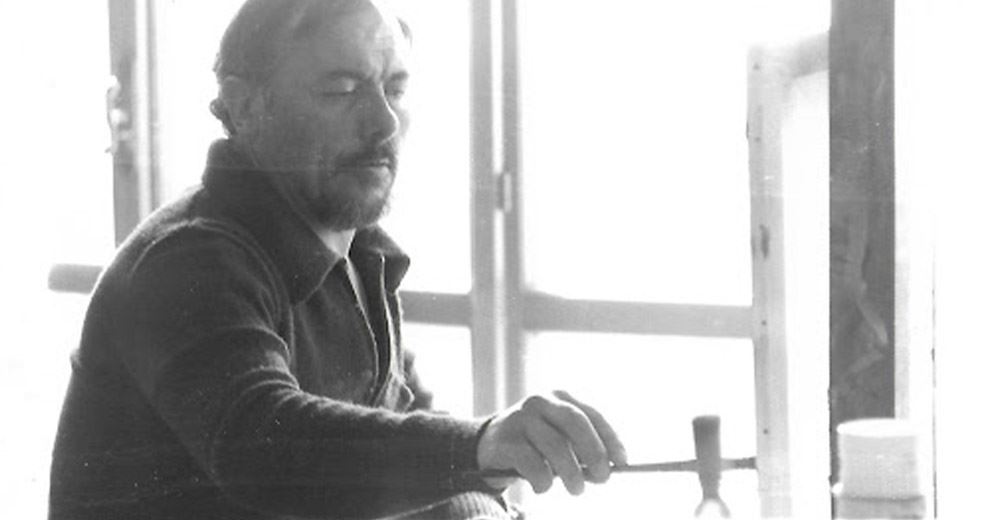Tomaso Pizio was born in Schilpario on September 17, 1932.
Since childhood he has shown great creativity and a need to reveal himself through the work of his own hands. This work initially translates into small inventions made with raw materials belonging to the primordial world of the native country, such as snow.
The first "sculptures" gradually give way to more serious and heartfelt experiments, experienced directly from the soul of Pizio-artist.
The growing passion for art materializes with the first paintings and the first competitions in which Pizio takes part; Finding the confirmations he had been looking for for some time, he decided to devote himself totally to the artistic world at the age of thirty, an age in which, moving to Bergamo, he was able to transform his passion into work.
His favorite subjects, from which he will never detach himself, are elements and evocations of his own land, the beloved country that he has always celebrated and respected. The source of inspiration for his creativity - his valley and his origins - confirms a marked sensitivity on the part of Pizio-artist, who demands to weld this ancestral relationship through painting.
First auditor at the Carrara Academy of Bergamo, under the guidance of Maestro Trento Longaretti, and then frequenter of the graphics course at the University of Venice, he pursues his investigations and research, reaching an artistic maturity which, however, will not yet be the definitive one. .
We are at the end of the sixties and the beginning of the seventies when the style of the brushstroke begins to take on a more characteristic trait of the artist.
These brushstrokes are short, but do not interrupt the figures, continuity is guaranteed by the color.
Subsequently - around the Eighties - the brushstroke begins to relax more and more, perhaps synonymous with greater serenity and safety in the personal, and therefore professional, sphere, until it reaches abstract forms, those that today are identifying the style of Pizio.
The uniqueness of his painting and sometimes of sculpture and drawing is generated by a strong dynamism of the figures, which enhance the artistic gesture and enliven each work.
Color is another common thread of pictorial works; brilliance, cleanliness and at the same time balanced and risky combinations are the signature of this artist.
Through the material and its shades, the artist's soul is fearlessly exposed with all its fragility and vulnerability; there are no filters or mediations, pure color is a mirror, a direct portrait, of an equally pure soul and sensitivity.
Pizio's figurative poetry is an invitation to everyone to take part in it; appreciated both in Italy and abroad, it creates a favorable international opinion around it, perhaps fueled by that same intelligence and creative vivacity.
Charisma and humility distinguish Pizio as an artist, but above all as a person, who he was able to maintain this positive influence until he died on February 18, 2003.
Tomaso Pizio's artistic curriculum is rich and heterogeneous; he boasts numerous prizes from national and international competitions.
Among the 15 first prizes we remember that of his debut, in 1969 in Paestum relating to painting, and that of 1988 in Gelatina relating to sculpture.
In 1973 he obtained the "Burchert" prize in Kempen, in the same year he participated victoriously in the Second Biennial of Art "Great Contemporary Masters" in Milan and in the Third European Biennial in Montecarlo; in 1992 he was appointed Honoris Causa member in Fidenza; in 2000 he was awarded by the Bergamo Chamber of Commerce and awarded the gold medal for artistic value; in July 2003 the First International Prize of the City of Castles in Caltanissetta was awarded to the family, at the exhibition hall of Palazzo del Carmine Cultural Association Art & Society; in 2006 he was awarded the Ulisse Memorial Prize at the Provincial Council Hall in Bergamo.
There are several archives that house his works, such as the Historical Archive for consultation of Modern and Contemporary Art, the Museum of Arts at the Bandera Palace in Busto Arsizio, the Archive of the Information Museum of Senigallia and the Museum of 'Modern Art of Abano Terme, as well as in the University of Sciences, Letters and Arts and the Multimedia Archive of Bergamo.
The journalistic and television services, both national and international, dedicated to the works of Pizio are more than 120; remember the Corriere della Sera, L'Eco di Bergamo, the Encyclopedia universal-Seda, Europa Artistica, Il Giorno, Il Resto del Carlino, Il Tirreno, L'Unità, Le Orobie, the Columbiam Periodical of Letters, Italo-Euro-American Arts, Here Bergamo; Rai services such as "Settimo Giorno", 1966, Tg3, Rai-tv third channel, Rai-tv service 1978-1980-1998, Il Ponte Italoamericano, America Oggi, La cote des Arts, L’Officiel des spectacles. There are countless exhibitions in Italy and abroad.
In Bergamo and the Province, the exhibitions at: San Bartolomeo Cultural Center, La Torre Gallery, XX Settembre Gallery, Galleria ex Ateneo are highlighted; Franca Pezzoli's Art Atelier - Clusone, Palazzo Visconteo - Brigano, and the municipal offices of Vilminore and Schilpario. Milan, Monza, Ferrara, Rome and Pompeii - where he was rewarded with the keys to the city - have often welcomed personal and group exhibitions of Pizio.
Eight foreign countries have hosted his art: Austria, Finland, France, Yugoslavia, Holland, United Kingdom, Switzerland, USA. Particularly active in the United States, where among the various exhibitions we remember the International-Artexpo New York, the American Labor Museum - New Jersey and Center West Palm Beach For Italian Studies.
Note his works in museums and public collections: Washington: Italian Embassy - The national Italy, American Foundation - Amnesty International USA; Pompeii: L. Ametrano art gallery; Bergamo: Carrara Academy; Monaco: CFM Credit Agricol Indosuez; Russia; Sry Lanka; Brazil; Peru; Australia; Canada; France; Spain; Switzerland; Hong Kong; Macau; Portugal; Yugoslavia; Venezuela; San Marino Museum.



 This site uses anonymous technical cookies to ensure navigation and third-party cookies to monitor traffic and to offer additional services such as viewing videos or messaging systems. Without third-party cookies some pages may not work properly. Third-party cookies can track your activity and will only be installed by clicking on the "Accept all cookies" button. You can change your selection at any time by clicking on the "Cookie" link on each page at the bottom left. By clicking on one of the two buttons you declare that you have read the privacy policy and to accept the conditions.
This site uses anonymous technical cookies to ensure navigation and third-party cookies to monitor traffic and to offer additional services such as viewing videos or messaging systems. Without third-party cookies some pages may not work properly. Third-party cookies can track your activity and will only be installed by clicking on the "Accept all cookies" button. You can change your selection at any time by clicking on the "Cookie" link on each page at the bottom left. By clicking on one of the two buttons you declare that you have read the privacy policy and to accept the conditions.